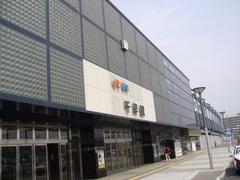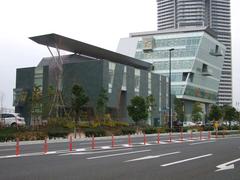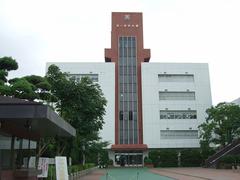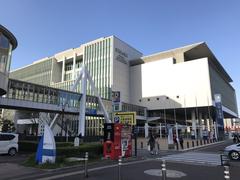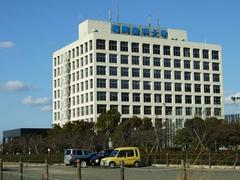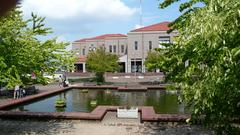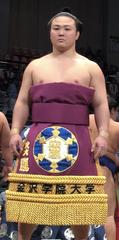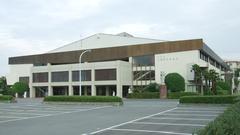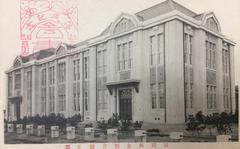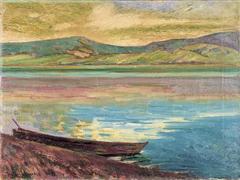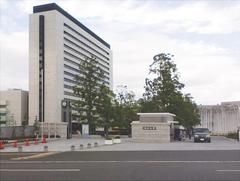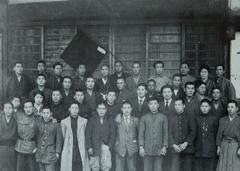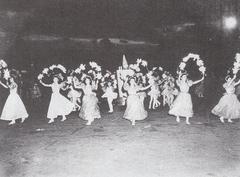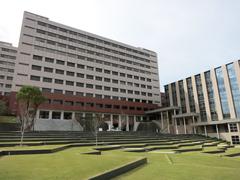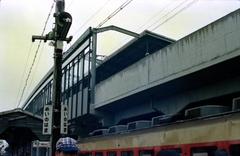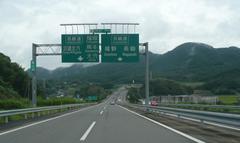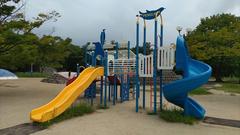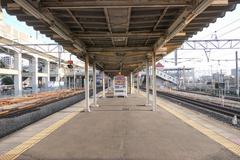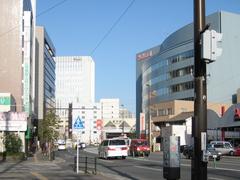Nanotsu Fukuoka: Comprehensive Guide to Visiting Hours, Tickets, and Attractions
Date: 04/07/2025
Introduction
Nanotsu, situated on the picturesque Hakata Bay in Fukuoka, Japan, is an area steeped in over a millennium of maritime history. As one of Kyushu’s earliest port settlements, Nanotsu played a pivotal role in shaping Fukuoka’s cultural and economic landscape, serving as a vital link between Japan, China, and Korea as far back as the Nara period (710–794 CE). The area’s significance is preserved through sites like the Korokan ruins, which once hosted foreign dignitaries, and the enduring legacy of Hakata, which evolved from medieval trade into a vibrant modern hub.
Today, Nanotsu offers much more than historical intrigue—it is a tapestry of spiritual sites, bustling festivals, traditional crafts, and culinary delights. Whether you are a history aficionado, a cultural explorer, or simply a traveler seeking authentic Japanese experiences, Nanotsu invites you to discover its rich heritage and contemporary vibrancy. This guide details Nanotsu’s historical significance, practical visitor information (hours, tickets, and tours), and highlights its must-see attractions, ensuring you make the most of your journey (fisop.net; gofukuoka.jp; visitinsidejapan.com).
Table of Contents
- Early Origins and Geographical Context
- Nanotsu’s Role in International Exchange
- Key Historical Eras: From Medieval Prosperity to the Modern Age
- Visiting Nanotsu: Practical Information (Hours, Tickets, Tours)
- Nearby Attractions and Travel Tips
- Nanotsu’s Cultural Significance: Festivals, Arts, and Community
- Culinary Experiences
- Nature and Scenic Spots
- Visiting Tochoji Temple
- Frequently Asked Questions (FAQs)
- Conclusion and Visitor Tips
- References
Early Origins and Geographical Context
Nanotsu’s strategic location along Hakata Bay established it as a key maritime gateway between Japan and the Asian mainland. Archaeological evidence confirms that by the Nara period, Nanotsu was already an active port welcoming foreign envoys and traders. Its natural harbor and proximity to the Asian continent (closer to Seoul than Tokyo) positioned it as a linchpin for cultural and commercial exchange (fisop.net).
Nanotsu’s Role in International Exchange
During the Asuka and Nara periods, Nanotsu became an essential hub for diplomatic and trade relations. The Korokan, an ancient guesthouse near Nanotsu, was constructed to host visiting dignitaries, highlighting the area’s significance as a diplomatic center (gofukuoka.jp). The Dazaifu government relied on Nanotsu as its primary port for foreign interaction, further cementing Fukuoka’s reputation as an international city.
Key Historical Eras: From Medieval Prosperity to the Modern Age
Medieval Prosperity
Nanotsu’s prominence continued through the Heian and Kamakura periods, fostering the rise of Hakata as a major trading town. The port enabled the exchange of silk, ceramics, and other luxury goods, attracting merchants, artisans, and religious figures who built temples and shrines in the area (travel4history.com). Defensive structures from the Mongol invasions (1274, 1281) remain as reminders of the region’s strategic importance (whatsinport.com).
Edo to Modern Era
Under the Tokugawa shogunate, foreign trade was restricted, and Nanotsu shifted to supporting internal commerce. The area flourished as a merchant district, renowned for crafts like Hakata-ori textiles. With the Meiji Restoration, Fukuoka and Hakata merged, and although modern infrastructure changed the area’s role as a port, its historical heritage remains celebrated (travel4history.com).
Visiting Nanotsu: Practical Information (Hours, Tickets, Tours)
Major Sites and Their Details
-
Korokan Ruins
- Hours: 9:00 AM – 5:00 PM (last admission 4:30 PM)
- Tickets: 300 yen (adult), discounts for students/seniors
- Highlights: Interpretive displays, reconstructed structures
- Access: Near Ohori Park, via Ohori Koen Station (gofukuoka.jp)
-
Fukuoka City Museum
- Hours: Tuesday–Sunday, 9:30 AM – 5:30 PM (closed Mondays)
- Tickets: 200 yen (adult)
- Highlights: Exhibits on Nanotsu’s history and international exchange (gofukuoka.jp)
-
Guided Tours
- Duration: 1.5–2 hours
- Cost: 1,500–2,500 yen
- Languages: English tours available; advance booking recommended (travel4history.com)
-
Accessibility: Most major sites are wheelchair-accessible and feature multilingual signage. Subway and bus services from Hakata Station provide easy access.
Nearby Attractions and Travel Tips
Combine a visit to Nanotsu’s historical sites with nearby attractions such as Ohori Park, Fukuoka Castle Ruins, and the lively Hakata district. Early morning visits help avoid crowds, and guided tours provide valuable context on local history.
Nanotsu’s Cultural Significance: Festivals, Arts, and Community
Festivals and Celebrations
- Hakata Dontaku Port Festival: Held May 3–4, features parades, floats, and traditional performances, drawing over two million visitors (tripjive.com).
- Hakata Gion Yamakasa: Every July, this UNESCO-recognized festival features teams racing floats to Kushida Shrine (cultureactivities.com).
- Funa-norikomi Boat Parade: Kabuki actors greet crowds from boats, celebrating the area’s maritime legacy (gofukuoka.jp).
Community and Traditions
Local residents are known for their “nobosemon”—fervent festival enthusiasm. Community-driven celebrations and the area’s famous yatai (food stall) scene foster a sense of social cohesion and hospitality (tripjive.com).
Arts and Crafts
- Hakata Dolls (Hakata ningyo): Distinctive clay dolls, often available in workshops for visitors (overyourplace.com).
- Hakata-yaki Pottery: Influenced by continental styles, with hands-on classes offered (adventurebackpack.com).
Religious Sites
- Kushida Shrine: A major spiritual center, integral to local festivals (overyourplace.com).
- Tochoji Temple: Home to Japan’s largest wooden Buddha, see detailed section below.
Culinary Experiences
- Yatai Street Food: Sample Hakata ramen, yakitori, and oden in open-air stalls—most operate from 6:00 PM until late (myjapanguide.com).
- Hakata Ramen: Rich pork bone broth, thin noodles; Nagahama area is a hotspot (livingnomads.com).
Nature and Scenic Spots
- Ohori Park: A tranquil lake, seasonal flowers, and walking paths; open daily 6:00 AM – 10:00 PM (edrawmind.com).
- Shikanoshima Island: Sandy beaches, hiking, and the site of the ancient Gold Seal (japaninsides.com).
Visiting Tochoji Temple in Nanotsu, Fukuoka
History and Significance
Founded in 806 by Kobo Daishi, Tochoji Temple houses Japan’s largest wooden Buddha and a striking five-story pagoda. The temple is a spiritual and cultural highlight of the Nanotsu area.
Visiting Information
- Hours: 9:00 AM – 5:00 PM (last admission 4:30 PM)
- Tickets: ~300 yen (adult), discounts available
- Guided Tours: Occasionally offered; check the temple’s website or local tourist centers
- Photography: Allowed in most areas
- Access: Subway to Ohori Koen or Tenjin stations, then a short walk or taxi ride (crossroadfukuoka.jp)
Facilities and Accessibility
- Wheelchair accessible in most areas
- Multilingual signage
- Restrooms and lockers available
Surroundings
- Accommodation: Options include business hotels, ryokan, guesthouses, and luxury hotels in Tenjin and Hakata districts.
- Dining: Numerous local restaurants, yatai stalls, and cafés nearby.
Frequently Asked Questions (FAQs)
Q: What are Nanotsu’s visiting hours?
A: Outdoor areas are generally open year-round. Key sites like Korokan Ruins (9 AM–5 PM) and Tochoji Temple (9 AM–5 PM) have specific hours.
Q: Are tickets required for Nanotsu attractions?
A: Many historical sites are free; some museums and temples charge nominal fees.
Q: Are English-language guided tours available?
A: Yes, for major sites and during festival periods; booking in advance is recommended.
Q: How do I reach Nanotsu from Hakata Station?
A: Subway or bus services provide direct access in 10–15 minutes.
Q: What’s the best time to visit Nanotsu?
A: Spring (cherry blossoms) and July (Hakata Gion Yamakasa festival) are highly recommended.
Conclusion and Visitor Tips
Nanotsu seamlessly blends its storied past with vibrant present-day culture. From the Korokan ruins and Tochoji Temple to energetic festivals and delicious street food, the area offers a holistic Fukuoka experience. Accessible, visitor-friendly, and rich in tradition, Nanotsu is an essential destination for anyone exploring Japan’s heritage. Plan ahead, download the Audiala app for real-time updates and guides, and immerse yourself in the living history and hospitality that define Nanotsu.
References
- fisop.net
- gofukuoka.jp
- visitinsidejapan.com
- travel4history.com
- tripjive.com
- cultureactivities.com
- overyourplace.com
- adventurebackpack.com
- myjapanguide.com
- livingnomads.com
- edrawmind.com
- japaninsides.com
- crossroadfukuoka.jp
